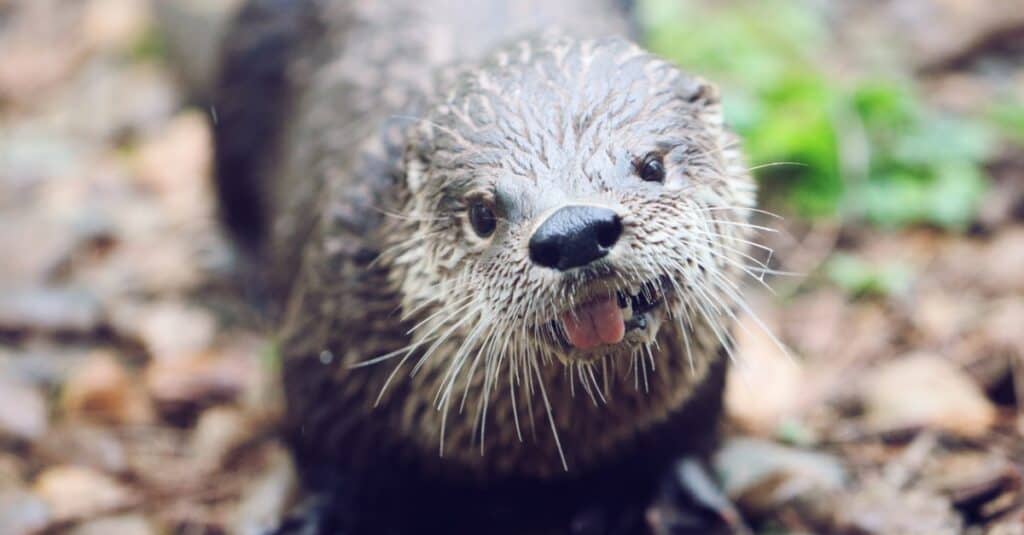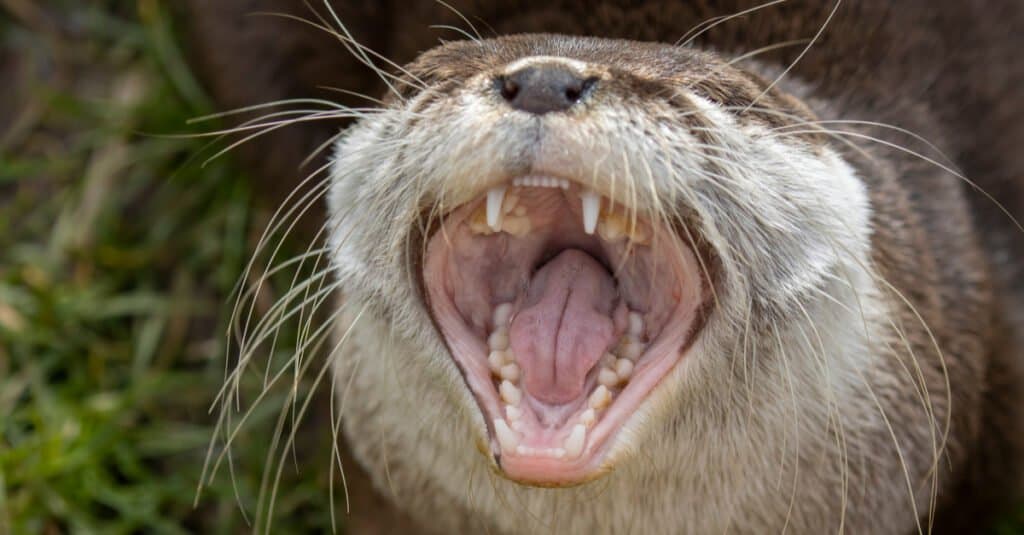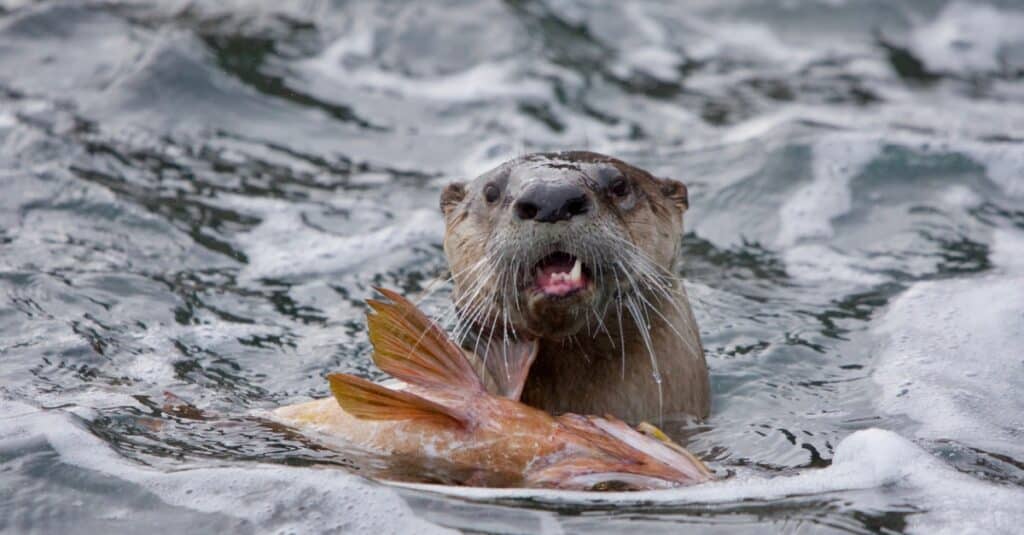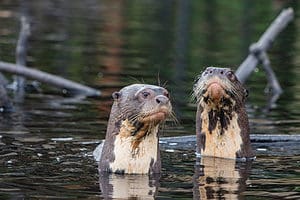Quick Answer:
- Yes, otters are somewhat dangerous.
- Humans are rarely attacked by otters, but otters are capable of being vicious, especially when protecting their pups.
Undisputedly, otters are one of nature’s wonders that are particularly friendly-looking and cute, even having their charismatic gestures capable of stimulating dopamine hormone in the human body. They are carnivores with a diet that includes a wide range of marine animals. Surprisingly, an intriguing fact that distinguishes these creatures is their distinctive nature to live as aquatics and semi-aquatics simultaneously. They have varying sizes across all species, weighing between 2.2 to 99.2 lb and having lengths between 2.0 to 5.9 feet.
Are otters dangerous? Let us learn more about this incredible creature as we read this article.
Background on Otter

Otters eat 15 to 25% of their body weight daily.
©iStock.com/Heather Burditt
Otters are generally described as long, slim-bodied, short-limbed creatures with powerful webbed feet for swimming and seal-like abilities to hold their breaths underwater. There are about 13 otter species, with some of them having a surprising daily appetite of 15% to 25% of their body weight. And one specific attribute common to them is their love for their favorite meal; fish. They mostly dwell in freshwater rivers and wetlands, except for the sea otters that inhabit the Pacific Ocean.
Being inhabitants of all continents except Australia and Antarctica, sea otters can be easily identified by their body morphology. They are small-sized with elongated bodies, a crown of short ears, and long tails that perform a rudder’s function. They are also furry (usually thick) and sparsely distributed across 13 species, with varying modifications or qualities.
It is worthy to note also that these carnivorous mammals are of the subfamily Lutrinae. Incidentally, they are good hunters fortified with waterproof and thick fur. Otters’ gestation period runs between 60 to 86 days. More often than not, some species of otters come ashore to give birth to their newborns in dens, although this is not the same for sea otters. But, are otters dangerous animals?
How Dangerous is an Otter?

Otters are dangerous wild animals that hurt and kill any prey that comes their way.
©Paul A Carpenter/Shutterstock.com
Are otters dangerous? Drifting from their pleasant gestures, otters can be somewhat dangerous. Calling to mind that these mammals are carnivores, they have a solid inclination to hurt and kill any prey that comes their way. Humans, however, are rarely attacked by otters, but it has happened. They can sometimes be protective of their pups.
Otters are no doubt vicious. Their firm jaws can deliver the right amount of support needed for their teeth to cause enough damage to their prey. To elucidate their dangerous hunting capacity, it will suffice to note that otters are built with sophisticated skulls, jaws, and teeth that can crush the thick exoskeletons of sea urchins. For comparison, the diameter of the hard shell of a sea urchin ranges from 1-to 4 inches; although fortified with spikes, they are still no match for otters.
What Threats Do Otters Face?

Otters are currently endangered.
©iStock.com/DanielLacy
For a very long time, otters have been hunted for their pelts. This practice dates back to 1700 and even beyond. They are valued for their softness and warmth and are an essential material used in making winter clothing—some of the hunting methods employed then included darts, arrows, and nets.
Undisputedly, even now, otters are endangered – the IUCN (International Union For Conservation of Nature) agrees. Unfortunately, their fur being in high demand relatively threatens their existence at this present time.
Can Otters Spread Infectious Diseases to Humans and Animals?
Are otters dangerous to pets? Aside from their powerful bite force, these aquatic/ semi-aquatic animals can also transfer zoonotic diseases like rabies through bites and scratches. Humans and pets are likely to get infected when close contact with this wildlife. However, preventive methods must be actively employed to avoid getting infected with rabies and Coccidioides immitis.
In a hostile encounter with an otter, one must be sure to seek medical help urgently because their bite can be infectious, and it can cause bone fractures and even death to the prey. So, it is wise and safe to keep a reasonable distance of about 150 ft away from otters. Pets should be on a leash when walked near otters and should be kept away from these dangerous animals.
Other Amazing Facts about Otters
- Besides preying on fish and sea urchins, otters also enjoy eating crayfish, crabs, birds, and frogs.
- Otters happen to be skilled in opening shellfish with stone. These stones help them smack open the shellfish’s stomach.
- Otters enjoy swimming and exploring the water, and they do this in a bid to scavenge for meals.
- The majority of the species live beside the water body, except for river otters which go into the waters for hunting or migration purposes.
- Sea otters are more active in the water than their counterpart, the river otter, who spends most of their time on land.
- Their furry luxuriance, organized as long guard hairs and soft, dense underfur, prevent their fur from getting waterlogged.
- Like the marine otter, some otters consciously spend more time on land despite having thick furs capable of keeping them warm in the ocean.
- River otters can be majorly found in North America and are fond of creating burrows close to the riverbank, swamp, lake, and coastal shore, as the case may be.
- They get creative with their burrows as they effortlessly make multiple passages to have seamless access in and out of the river.
- Apart from fish and frogs, they prey on mice, squirrels, birds, salamanders, mussels, snails, and turtles.
- A male otter is called a boar, while a female otter is called a bitch.
- Interestingly, bitches attain sexual maturity at approximately twenty-four months, while it takes boars thirty-six months to become sexually mature.
- Baby otters only enjoy twelve months of care from their mothers, and they begin to swim after two months.
- Generally, when otters are not on the move to hunt, they engage in various enjoyable activities, including water sliding.
- Sometimes, they can be seen playing around with little stones on river banks.
- All otter species vary in certain aspects, such as social adaptation and pups delivery.
- Some otters can live alone in solitary, while others in Alaska prefer to live in gigantic groups.
The photo featured at the top of this post is © iStock.com/bazilfoto
Thank you for reading! Have some feedback for us? Contact the AZ Animals editorial team.






